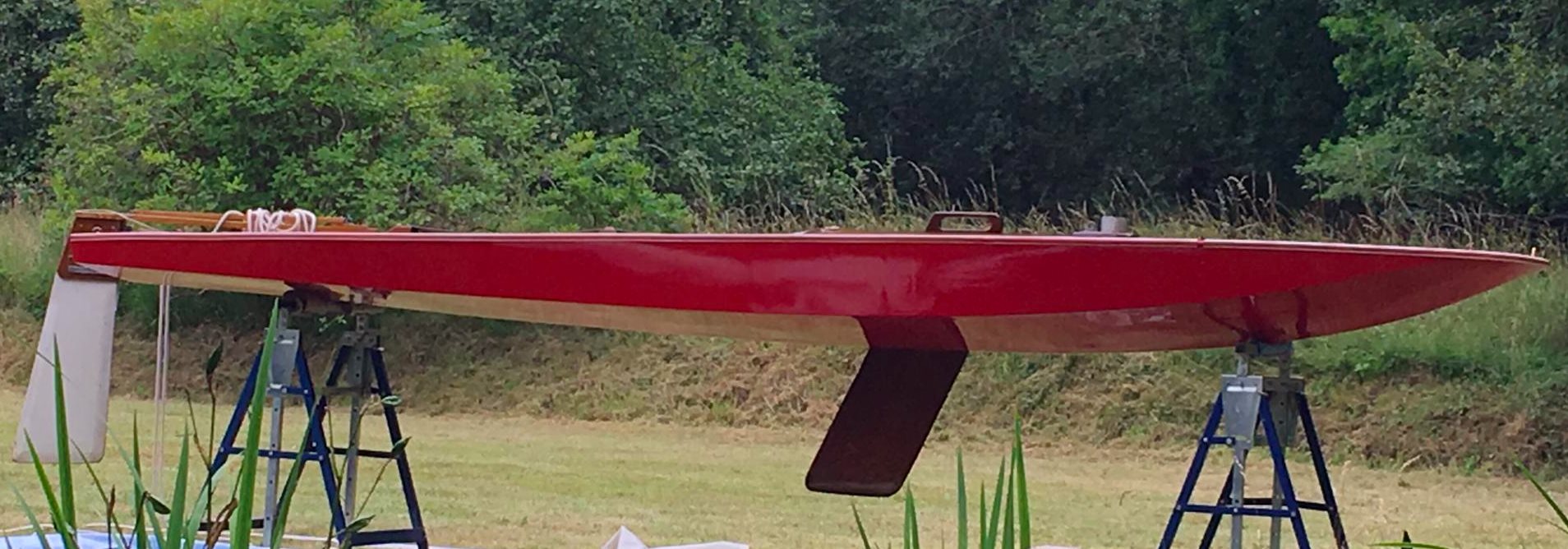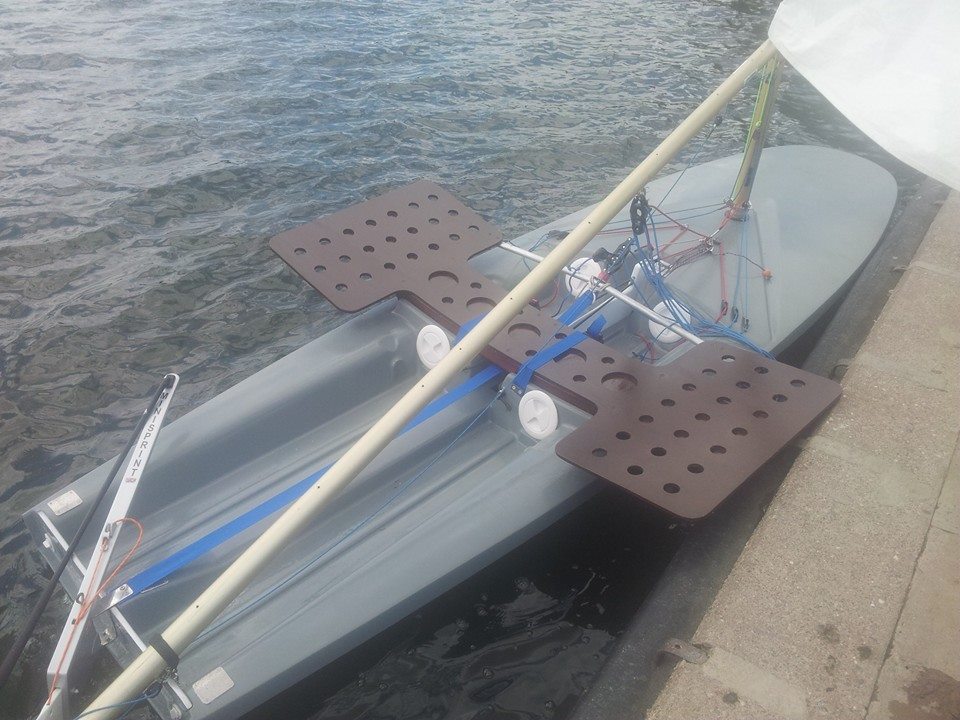The Article below is a personal look at the state and future of the Minisail class by Ed Bremner, founder member of the Classic and Vintage Racing Dinghy Association (www.cvrda.org), who, despite (or possibly because of) his love of old racing dinghies, enjoys casting a keen eye into the future.
This was first published here on Rupert Whelan's blog.
But What if you...?
Some thoughts on further development within the Minisail class.
Hi, I guess I should first introduce myself, my name is Ed Bremner and I am the owner of two Minisprint MkII II hulls and one set of 'rig and foils’, none of which are quite yet ready to sail. I started sailing at a young age with my father in a Fairey Jollyboat, mainly in the idyllic surroundings of the Greek island of Skiathos. But the first single hander I sailed was an early Minisail Monaco 1, with the flat flush decks. My father bought 3 or 4 to be rented out from our local taverna. Now to be honest, I have to admit... I wasn't a great fan of those boats, much preferring to crew for my dad in the Jollyboat, but nonetheless, they have always held a special place in the memory of my childhood.
This post is a few of my thoughts on the Minisail as a development class. What does that mean and where could it go from here.
Why did the Minisail class fail?
It is hard to think of any dinghy class that has gone from having such a large number of registered boats and a busy racing schedule to disappearing and becoming a 'lost class', seemingly almost overnight. However, I think that one should remember that most Minisails were bought by families simply for 'fun' sailing rather than racing and it is normally 'racing' and indeed 'racers' that are always the back-bone of any class, so when the racing stops... it is not long before the class collapses.
So why did the racing stop? Well, I am sure there were many reasons, but reckon that the arrival on the market of both the one-design Laser, better suited for racing and the one-design Topper, better suited for family, (but still with good racing), were the main reasons. So that begs the question of whether the Minisail would have done any better if it had taken more effort to remain a true one-design rather than allow itself to become a semi-development class. I think one of the reasons that the Laser and Topper took over was simply because they were such strict one-designs in an area of the market and at a time that this was exactly what people wanted.
So, is it really a development class anyway?
OK, but is the Minisail truly a development or semi-development class anyway? Yes, there are at least 2 hull designs and at least 5 different deck layouts, with countless other mixes between the two including sliding seats, racks etc... all of which can be chosen or disregarded, depending on the water you sailed on. But still to me, these seem more like 'choices' rather than evidence of true 'development' as such. It seems a similar situation as the National Firefly, which has 4 different internal/deck arrangements, three possible masts, two rudders and two centre-plates and yet, that class considers itself a one-design, not a semi-development class.
To look at it from another angle, I find it very interesting and remarkably telling, that no different PY number was ever given for the Sprite, Monaco or Sprint, with just the qualification that some of these designs went better on the sea, some on the lake, some in a blow and some in a drift and a presumption that in the end it would all kind of average out.
I would like (most humbly) to suggest that the Minisail doesn't seem like a true semi-development class, simply because there hasn't been any real development since the class started to fold and with the great benefit of hindsight to point out that it may well have been the attempts to bring the class up to date, with the Minisprint MkII which actually had the effect of hastening the death of the class all together.
But here, I will come clean, I love development classes. I am not going to suggest that the differing designs were a bad thing or that development was bad for the Minisail. It is, for me one of the main reasons I like the class. Dinghies are all about tinkering, thinking, changing, personalising, building.....which is all 'development' and I love it. Long may development continue in the Minisail.
So what does it mean to be a development class?
Let 1000 ideas flourish! The Minisail is a semi-development racing class.... or so the brochure says!
OK... but if Minisail is a semi-development class, then what would we develop next?
Well, this is the kind of question that runs through my head as I go to sleep at night and diverts my mind in those long boring meetings, scribbling little drawing on the back of the agenda. So, how do we make a Minisail go better and what development would be possible within the ethos of the class and what lies outside the current rules?
It also begs the question: What do we want from the class anyway? Do we want to develop it... or should the remaining boats be left as they are, in aspic? Are we interested in building new boats?
I think we also need to consider some of the same design issues and fundamental questions that possibly lead to the demise of the class in the first place. Do we want a family boat, or a racing boat? Do we want it to sail on the lake or sea? Is it possible to have one class that does all these things anyway?
I don’t have the answer to these questions, but it amuses me to roll the possibilities over in my head at times and I would really like to encourage all of us to have a little fun kicking some ideas around.
Further Development of the Minisail Class
So where could we take development of the Minisail:
We can break this down into two threads of thought -
1. What development is possible within the current rules?
2. What rules could be changed to allow further development?
Within the current rules
So what could be done within the rules: Well, I have a brace of Minisprint MkIIs and my thoughts on development are based around that design, which I basically like.
First and most importantly, I would do everything that I possibly could to bring any new boat's weight down to the class minimum. The class rules state a minimum weight of 43.09kg. This is very reasonable. Let's put this into context, until recently (new rules) the 'bare-hull' weight for an International Canoe was 63Kg. The Minisail weight is 20Kg less than one of the fastest mono-hulls in the world. The snag is that of course, I sincerely doubt that any glass Minisail comes anywhere close to this minimum weight. I have not weighed my hulls yet, but they are considerably harder to move around and turn over than my IC, which is severely overweight at around 80Kg. I wouldn't be surprised if my hulls were around twice the class minimum weight? Removing weight ("only useful in a steamroller" - Uffa Fox) is the one guaranteed way to make a boat faster, easier to sail and better fun.
The Minisail has a daggerboard of free size & depth. But the Minisprint MkII, has a short centre-board, which although may be more practical is going to do nothing for the upwind ability of the boat (and leads to you carrying more water and weight). So in a perfect world, I would replace the c-board with a nice long (36in) daggerboard, but more pragmatically, I think I would consider extending the centreboard slot and lengthening the c-board, about as far as I could, before I ran out of room, which I think will still be shorter than 36in. As the slot was now bigger, there would be even more of an issue about carrying all that water, so the slot would most probably need gaskets.
A bigger challenge is to work out some way of making the seat able to come further aft for when off the wind. I have some ideas on this, mainly around the concept used by the Unit dinghy, where the seat has a slot down it's length which holds a mushroom in the centre of boat, allowing the seat to swing in and out as well as fore and aft. This would require a quite a bit of butchery, but after extending the board-slot, it wouldn't be such a big issue.
The rigging and sail could really do with some work too, but these are all well restricted by the rules, so beyond some careful exploration of stiffer sections for the mast and a good sail-maker, I don't think there is much that you can do.
The sheeting could also do with some thought, but I am going to leave my thoughts on that till after I have sailed them a bit more.
What would you change in the rules?
OK, so far more interesting, lets think 'blue skies'. What rules would one change to allow the boat to develop into a fun boat of the 21st century?
The Hull Design? Maybe, there have already been two hull designs, so why not more? It would be quite easy to write a simple box rule which restricted the designs to the kind of surfboard shaped scow that we associate with the Minisail. It would be quite in character with the class. I am sure there are plenty of aussie scow designs that could be easily modified to fit. But to be honest.....if it wasn't for the fact that there are already two hull designs, then I would suggest we should stick to the current choice of hull designs we have for our further development.
But, if there were new plastic boats to be built, then it should certainly be to the min weight and we should encourage trying out different building techniques, other than simply solid polyester glass-fibre. Building in epoxy/glass/foam or epoxy/carbon/foam are both very possible these days and would allow a much stiffer and lighter boat. (Remember that lighter/stiffer = more fun and easier to sail). Taking a female mould off a late monaco hull would not be hard, building some simple new deck moulds would be harder but by no means impossible, or easier to build the decks in light cloth backed ply.
But let’s be really pragmatic. Using an old monaco hull as a male mould and vacuuming down a foam shell over that, would give you a hull only 6-8mm wider. OK, different for sure, but most probably still within the building tolerances allowed for wooden boats? This would be very easy, especially for one-off builds.
What about the rig/sails?
This would provide the biggest gains from a change in the rules. I am sorry, but as much as the triangular un-supported sail almost defines the Minisail look, I think it would really just have to go. What would replace it? A simple fully battened sail, with luff-sleeve based on a windsurfing sail, but with conventional boom. This would need a much more advanced mast. Possibly all carbon, or more pragmatically a stiffer aluminium base, topped with a carbon or glass top-mast. Possibly a laser bottom section with a windsurfer mast for top section.
Size wise, I would think a small growth in size up to around 8 or 8.5 sqM which would most probably give the lighter boat a much improved performance whilst remaining easily sailable. Of course, the battens would make the rig impossible to wrap around the mast, but I think this is only a good thing. Different sized sails could easily be catered for on shorter or longer top-masts.
This would all require more sitting out, so either sliding seat or racks will be necessary. But, I think that seat length should remain at the current length, which allows 'pussy-hiking' but not full 'off-the-end-of-seat' hiking, allowing the seat to remain a basic and light structure. I strongly suspect that the best arrangement will be for lightweight carbon tube racks, attached to the boat, although it would necessitate keeping the boat truly flat and muck up any attempts at roll-tacking.
I think the boat should certainly remain una rigged as this is a key part of the identity of the Minisail, but with an allowance for old boats to carry lowers to support the mast at gooseneck level so as to prevent breakages of old kit when using the new larger sail.
So could you go further than this??
Of course, the sky is the limit. Could it carry a bowsprit and genaker. Yes, I think so....not from the masthead, but a 3/4 setting, yes. It might require stays though and I would agree that this would be outside what I felt was the accepted class ethos.
Foils? Well that might be a step to far, but if the boats were light enough and the sails big enough, I guess it might be possible.
But maybe all of this is well outside your idea of the ethos of the class....that's cool.....but thinking about it, still gets me through those long dreary meetings.
So what do you think?


